

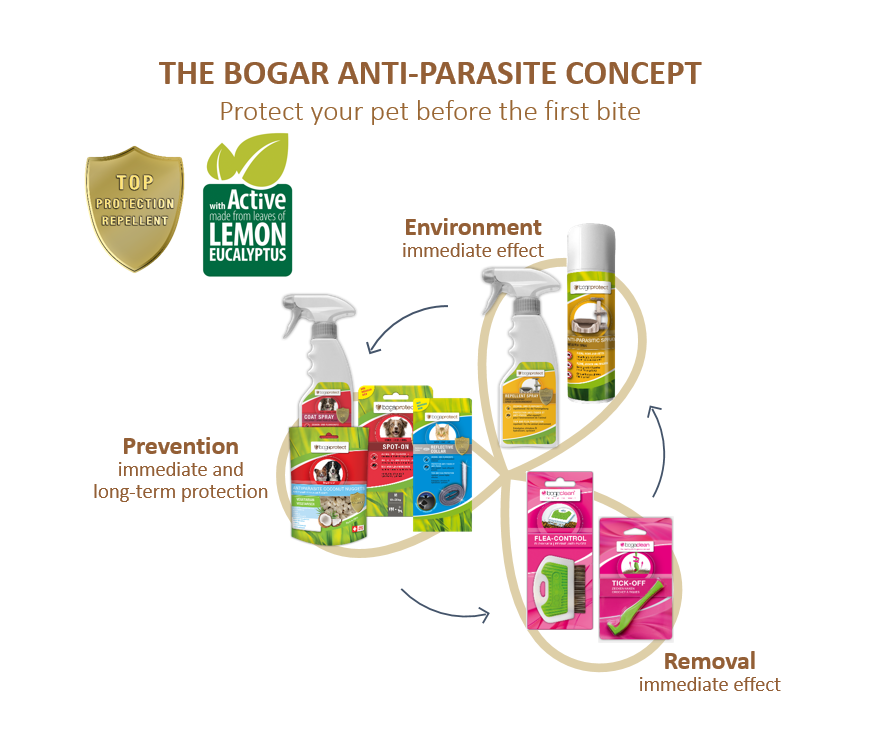
- Display 15 Products per page



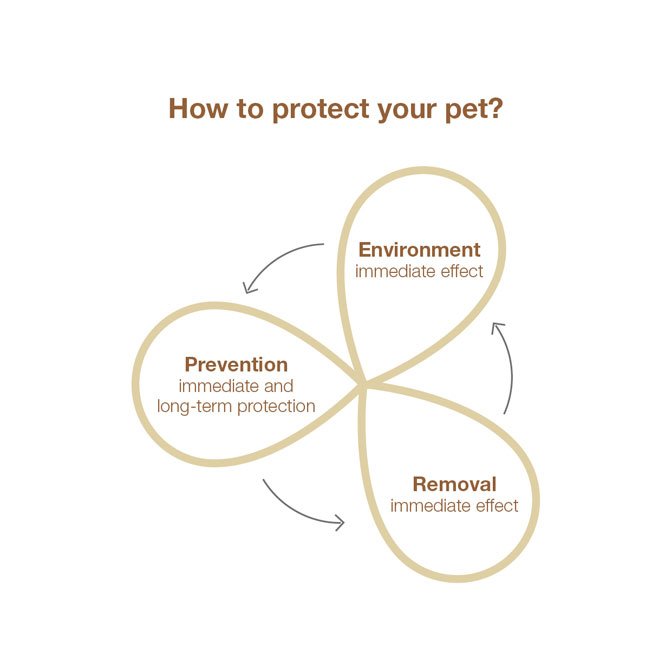
Prevention is better than cure. To shield your pet and its environment, bogaprotect® is exclusively relying on active substances of plant-based origin with a repellent effect. For your pet, you can choose between immediate and long-term protection.

1 pack of bogaprotect® SPOT-ON protects your dog or cat from flea or tick infestation for 3 x 4 weeks.


1 bogaprotect® COLLAR protects your dog or cat from a flea or tick infestation for up to 12 weeks.

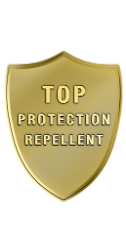
bogaprotect® COAT SPRAY protects your dog from flea or tick infestation with immediate effect for up to 24 hours per application. The coat spray can be used for the targeted and area-specific reinforcement of tick protection or, with daily application in sufficiently large doses, as sole protection too.
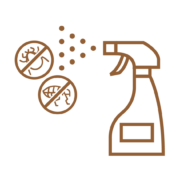

bogaprotect® REPELLENT SPRAY preventively protects your pet’s environment, and thus your pet too, against fleas and ticks.


To get rid of fleas and ticks, when it is already too late you can use the bogaclean® ANTI PARASITIC SPRAY or our FLEA FOGGER.


Use biocides safely. Always read the label and product information before use.
When your dog or cat has caught a tick or some fleas, you can detect and remove them with special tools.
A tick hook is a good way of removing ticks that have already bitten your animal. This way you reduce the risk of not removing the head of the tick, what commonly happens when ticks are removed unprofessionally.
Brushing the fur with the flea comb can tell you if your dog has caught some fleas.

The best from both worlds: natural origin paired with science. Used in immediate and long-term protection against ticks and fleas.
Oil from the leaves of the Lemon eucalyptus tree (Corymbia citriodora) – a unique mixture of at least 23 individual plant components.Therefore, resistance will not develop. The individual components reinforce each other’s effectiveness.
Our EC oil has an enhanced effect by a unique manufacturing process: Up to 72% content of highly insect-repellent PMD (p-methane-3,8-diol).
The special manufacturing process imitates the natural ageing process of the leaves. The naturally occurring citronellal content in the leaf is converted into PMD. PMD has excellent insect repellent properties, comparable to low concentrations of DEET (a synthetic agent used for malaria prophylaxis).
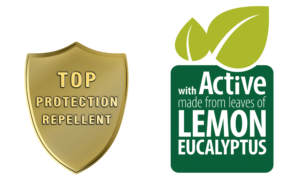
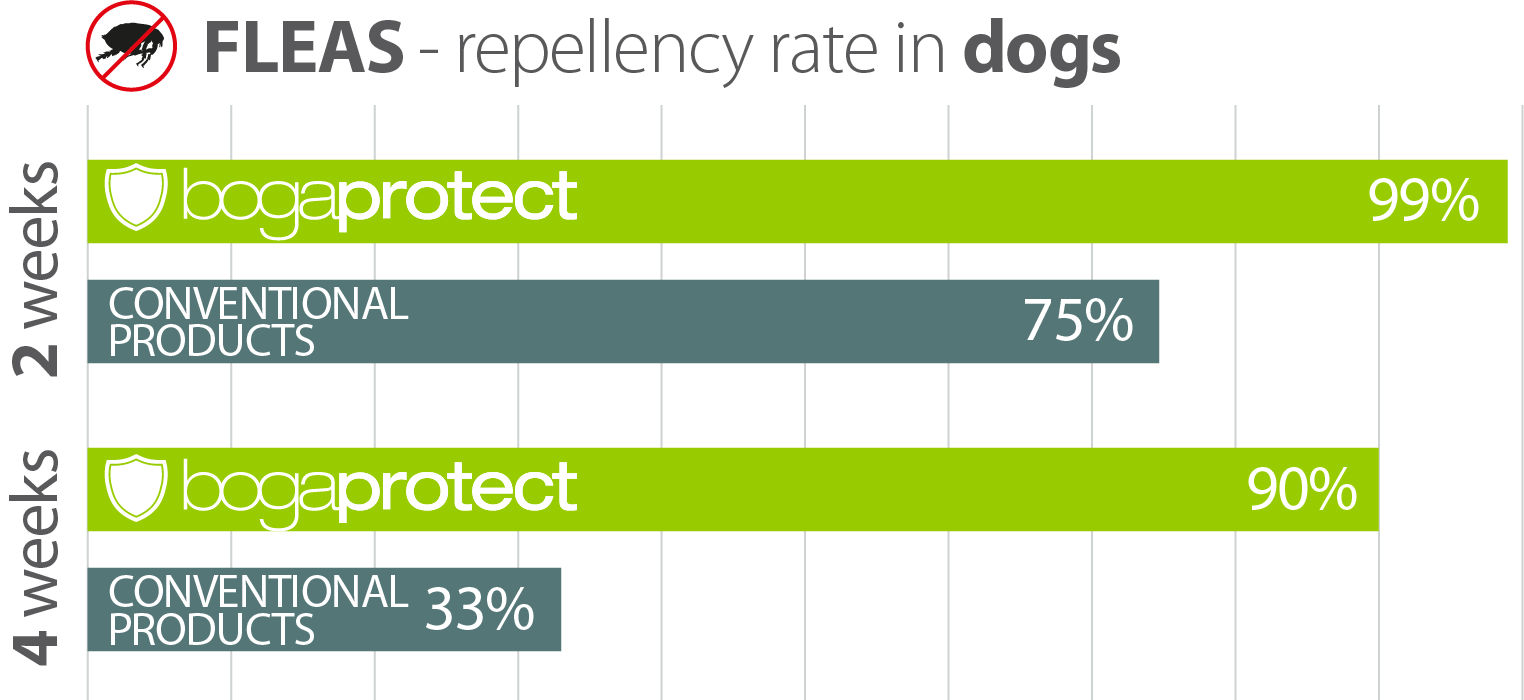
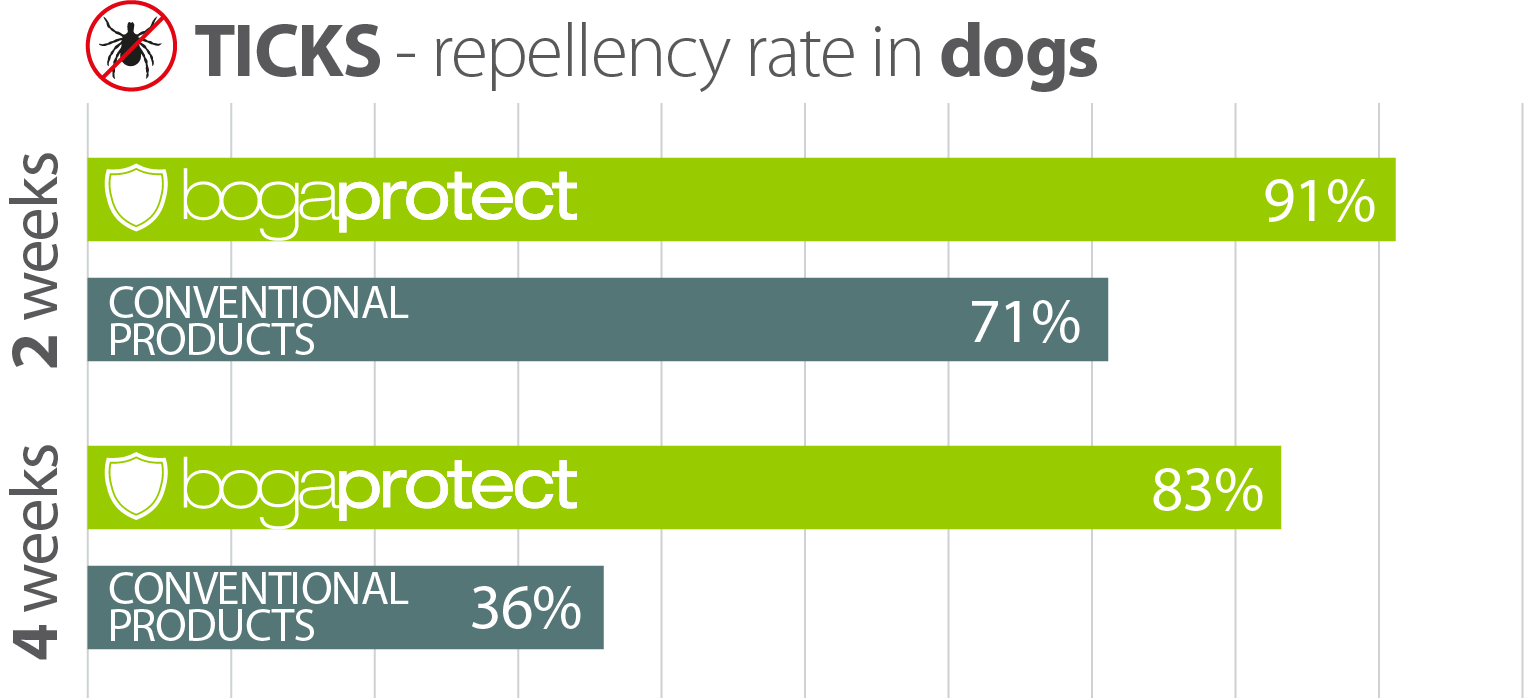
A comparison field study on the efficacy of flea and tick protection of bogaprotect® in a simulated use test under real-life conditions vs. other repellent brands, researched in cooperation with a university.
Preventive protection against fleas, ticks, mites and mosquitoes* (repels without killing). Bogaprotect® repels 90% of fleas after 4 weeks!
In humans – As the only active ingredient of natural origin: Recommended and approved by authorities and health organizations to protect against the transmission of malaria and the Zika virus.
*bogaprotect® SPOT-ON, COAT-SPRAY and REPELLENT SPRAY is containing that active substance. These products have been tested and approved for PROTECTION AGAINST FLEAS AND TICKS. The effectiveness of the products against mites and mosquitoes has not been proven in dogs and cats, only in humans.
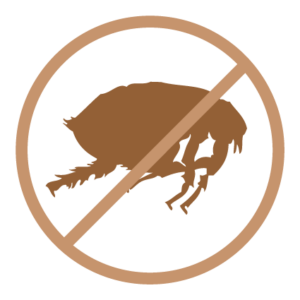
Does your pet often scratch, gnaw or lick different parts of its body? Is it restless? Itching can have very different causes. Before searching for further reasons, the possibility of a flea infestation must always be excluded first. Flea bites cause itching at the location of the bite.
Can you see any changes in your pet’s skin, such as scabs, redness or unkempt and thinning fur? As your pet seeks to relieve itching by scratching, gnawing and licking, secondary skin changes can arise.
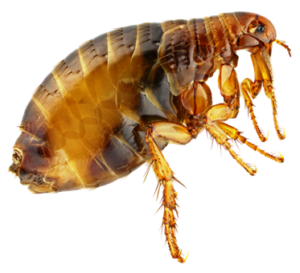
Characteristics: Adult fleas are about 0.15 to 0.45 cm long and dark in colour (brown to reddish brown). They have a distinctive laterally flattened body with a strong chitin exoskeleton, which is why they cannot be easily crushed. They are wingless insects with six legs. For fast movement, they have a strong pair of hind legs, which allows them to jump almost a meter in distance.
If you discover even a single flea on your pet, whether spontaneously or with the help of the flea comb, this is proof of a flea infestation. If, on the other hand, you do not find any adult fleas, a flea infestation cannot be ruled out: Fleas do not stay on their hosts permanently, and cats in particular are able to quickly eliminate fleas due to their meticulous grooming behaviour.
Comb the coat thoroughly with a flea comb. Do you come across any small black specks that look similar to ground pepper? These could be flea dirt. Flea dirt is excrement from digested blood of the host animal. You can distinguish these from harmless bits of dirt by carrying out a Flea dirt test.
Flea dirt test: Apply the suspect black specks on a damp cotton ball and rub lightly. If slight reddish discolourations occur, this is digested blood = flea droppings. This test proves that there is a flea infestation even if you don’t find any adult fleas on your pet.
Due to their repellent properties, products with active substances of natural origin are ideal for preventive use in order to protect against infestation. For the treatment of an existing and pronounced flea infestation, however, you should first resort to a veterinary drug which kills fleas. This ensures that all existing fleas on your pet are reliably eliminated and rendered harmless.
In less serious cases, you can use bogacare® FLEA POWDER for the gentle removal of fleas. This must be applied to pets repeatedly at intervals of 2-3 days.
Remember to treat all cats and dogs in the household, including those which do not show any signs of having fleas.
Since fleas transmit tapeworms, you should always deworm your animals after the flea treatment, using a suitable veterinary drug.
Mechanical control measures: Clean all potentially contaminated rooms thoroughly. This includes floors, surfaces which your pet lies on, upholstered furniture, transport boxes. Do not forget about the animal area in the car. By vacuuming once a day, the number of eggs, larvae and adult fleas in your pet’s environment can be greatly reduced. Flea pupae adhere so strongly to textile fibres that they cannot be removed by vacuuming alone. They can, however, be caused to hatch by the vibrations of the vacuum cleaner and can then be removed more easily in this form.
Caution: Eggs and larvae can survive in the vacuum cleaner bag. Seal the bag so that it is airtight before throwing it into the household waste, or freeze it for at least 12 hours.
Smooth floors should also be wiped regularly with a damp cloth and normal cleaning agents.
Wash textiles such as blankets etc. at a temperature of at least 60°C. Alternatively, you can freeze non-washable or temperature-sensitive textiles for at least 12 hours.
Insecticide sprays with instant effect:
These sprays are suitable for the treatment of individual surfaces, such as your pet’s sleeping area or the animal area in the car. This should be carried out once thorough mechanical cleaning has taken place. They contain active ingredients which kill all adult fleas immediately on contact, as well as mites and ticks. The effect lasts for a few days.
Insecticide flea fogger with long-term effect:
If you have to treat entire living areas, the use of a flea fogger containing a flea growth inhibitor is the right choice. The fogger distributes a fine spray of mist by means of an automatic spray mechanism, which even penetrates into fine cracks. The effect lasts for up to 6 months.
95% of the flea population lives invisibly as eggs, larvae and pupae in your pet’s environment. Here, they mature into adult fleas, which can re-infest your animal. This is why foggers with a long-term effect contain not only insecticidal active ingredients but also flea growth inhibitors. Thus, the development of immature fleas through the various stages into adult fleas is prevented and all stages of development in your pet’s environment will be reliably eliminated.
Use flea protection at regular intervals to prevent your pets from being re-infested.
Certain animals react to components of the flea saliva with a hypersensitivity reaction. In these animals, a single flea bite can lead to allergic skin inflammation due to antibody formation in the body, which lasts long after the period of the flea bite. These animals suffer from particularly intense itching. In addition, skin changes such as skin redness, hair loss, scabs and skin thickening, which typically occur in the area of the rear half of the body, can be observed over time. In chronic cases, the skin may show darker pigmentation in the affected areas.
In acute cases, animals with an allergy to flea bites also benefit from veterinary support to alleviate allergic itching in addition to flea control. These animals also need year-round and consistent flea prophylaxis.
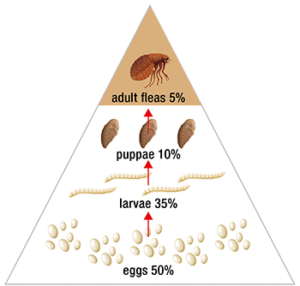
Adults (apparent 5% of the flea population): Live on the bodies of dogs and cats. This is where the blood sucking and egg laying takes place. The flea eggs fall off the host animal and thus are spread throughout the environment.
Eggs, larvae, puppae (inapparent 95% of the flea population): Live in the animal environment, where eggs mature via larvae to pupae, stages and finally infest dogs and cats as adult fleas. For sustainable control of flea infestation, the animal environment must therefore be included in the control measures.
Fleas are active throughout the year. Fleas can multiply rapidly in a short period of time. Fleas transmit tapeworms. They can also lead to allergic reactions, inflammations, as well as bacterial infections of the skin.
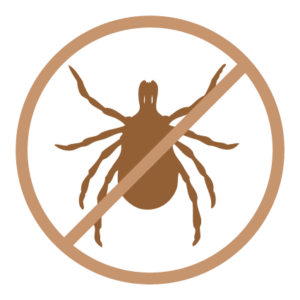
Ticks develop via several stages of development from eggs to larvae to nymphs, which eventually develop into adult ticks. Before laying the eggs and for each of these development steps, the tick needs to suck blood lasting several days in which time it infests a mammal. The entire development cycle lasts, for example with the castor bean tick, about 2–3 years.

Ticks are active from March to October and can be found everywhere in nature (high grass, bushes). The actual tick bite is painless and usually has little consequences for animals. However, especially in dogs, they can transmit life-threatening diseases such as babesiosis or Lyme disease.
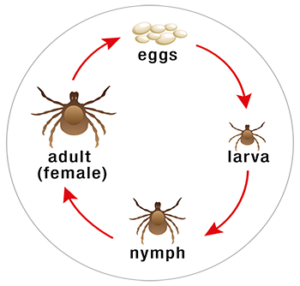
Step 1 – Apply the Tick-Off tick twister: Grasp the tick head as close as possible to the skin and twist it out with a careful twisting motion. Do not exert any pressure on the tick body, do not drizzle the tick with oil or other substances. Removing the tick as early as possible significantly reduces the risk of disease transmission.
Step 2 – Disinfect the bite site.
Step 3 Consistent prevention: Regular application of tick protection, to prevent your animal from being re-infested.
Video 1:Why is tick and flea prevention important for your pet’s health?
Video 2:The Bogar concept – How to apply the immediate and long term repellent effect products
Download for free our Petcare 1-0-1 to give your furry friends its best life!